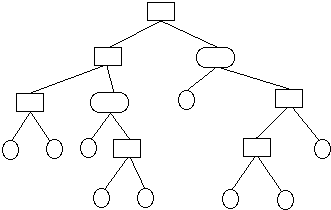
Spring Semester, 2001
Visitor Pattern
© 2001, All Rights Reserved, SDSU & Roger Whitney
San Diego State University -- This page last updated 25-Feb-01

|
CS 635 Advanced Object-Oriented Design & Programming Spring Semester, 2001 Visitor Pattern |
|
|---|---|---|
|
© 2001, All Rights Reserved, SDSU & Roger Whitney San Diego State University -- This page last updated 25-Feb-01 |
Visitor
Example - Trees

What about preorder visit, postorder visit?
What about an HTML print?
What about printing a 2D representation?
What if this was an expression tree - evaluation?
What if this was a binary search tree - adding, deleting
What about balancing the binary search tree -
Solution 1
Build all the operations into the tree structure
This works in many situations
If you need to add a lot of operations the classes can become cluttered
class BinaryTree { public String htmlPrint() { blah} public String 2DPrint() { blah} public String preorderTraversal() { blah} public String postorderTraversal() { blah} public String avlAdd() { blah} public String RedBlackAdd() { blah} etc. }
Solution 2
Use different classes or subclasses for the different types of trees
Does not work in classes we want to be able to mix all combinations
class BinaryTree { blah } class AVLTree extends BinaryTree { blah } class RedBlackTree extends BinaryTree { blah } class PreorderTree extends BinayrTree { blah } etc.
Solution 3
class BinaryTreeNode {
public void accept(Visitor aVisitor) {
aVisitor.visitBinaryTreeNode( this );
}
etc.
}
class BinaryTreeLeaf {
public void accept(Visitor aVisitor) {
aVisitor.visitBinaryTreeLeaf( this );
}
etc.
}
abstract class Visitor {
abstract void visitBinaryTreeNode( BinaryTreeNode );
abstract void visitBinaryTreeLeaf( BinaryTreeLeaf );
}
class HTMLPrintVisitor extends Visitor {
public void visitBinaryTreeNode( BinaryTreeNode ) {
HTML print code here
}
etc.
}
Structure
This is more complex than solutions 1 & 2
The structure, an iterator, or the visitor can do the traversal
When to Use Visitor
Consequences
Variations
Function Overloading
Overloading allows the accept method to be implemented once in the Element class
Eliminates cyclic compile dependencies
ExtrinsicVisitor
The Visitor takes the responsibility of making sure a visitor can visit a particular concrete element
Each Visitor knows which types of concrete classes it can visit
The canVisit method of each visitor returns true if that visitor can visit that concrete type
New visitors can be created without changing the Element classes
New Element classes can be added without having to change old visitors
The above is slightly modified from the original ExtrinsicVisitor pattern
In the original